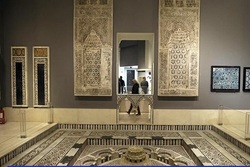Cairo Islamic Art Museum Turns 119


On Dec.28, 1903, the museum was officially inaugurated and soon after acquired its precious 4,500 artifacts.
MIA was the first museum in Egypt and the North Africa region to bring together iconic works of Islamic art.
To mark this occasion, the Supreme Council of Antiquities (SCA) is organizing three temporary exhibitions run through to January in the museum's halls.
The secretary-general of SCA, Mostafa Waziri inaugurated the three exhibitions, including antiquities and art displays.
Waziri explained that the first exhibition, titled ‘119 Years of Arts and Creation,’ is a collection of archived photos, history books, and artifacts that relate to Islamic arts and civilization along the span of history.
While, the second exhibition is a collection of 100 Arabic calligraphy paintings by renowned artists from Egypt, China, Japan, Thailand, Iraq, and India.
And the third exhibition comprises seven replicas of Islamic masterpieces carved in collaboration with the Beit Gamil for Historical Arts and the Cultural Development Fund.
MIA was founded in the late 1800s as the Museum of Arabic Foundations and housed in the Fatimid Ruler El-Hakim Bamr Allah building of the Ancient Cairo Complex, by the great Austrian scholar of Hungarian descent and the head of the technical department at the Awqaf Julius Franz.
At that time, Franz decided to create a museum to bring Arab art and Islamic treasures to the Egyptian people.
The museum was renamed the Museum of Islamic Arts as Khepe Abbas Helmy II took the throne and moved to its present location near the Cairo Governorate building.
After the grand restoration works, the Museum of Islamic Arts re-opened in January 2017, after 3 years hiatus with special exhibitions to celebrate its hundredth anniversary.
The core collection of the museum comprises Islamic artworks collected from across the Umayyad, Abbasid, Mamluks Ottoman Empires as well as the Fatimid era.
These oriental works and treasures include swords, the most ancient Kaabba's cover 'Kiswah', old Arabic parchments, manuscripts, metalwork, glassware, pottery collections, woodwork, and ethnographic materials.
The collection represents an extensive period ranging from the rise of Islam to the 1900s and the vast geographical area ruled by the Islamic Empires.
Source: see.news



